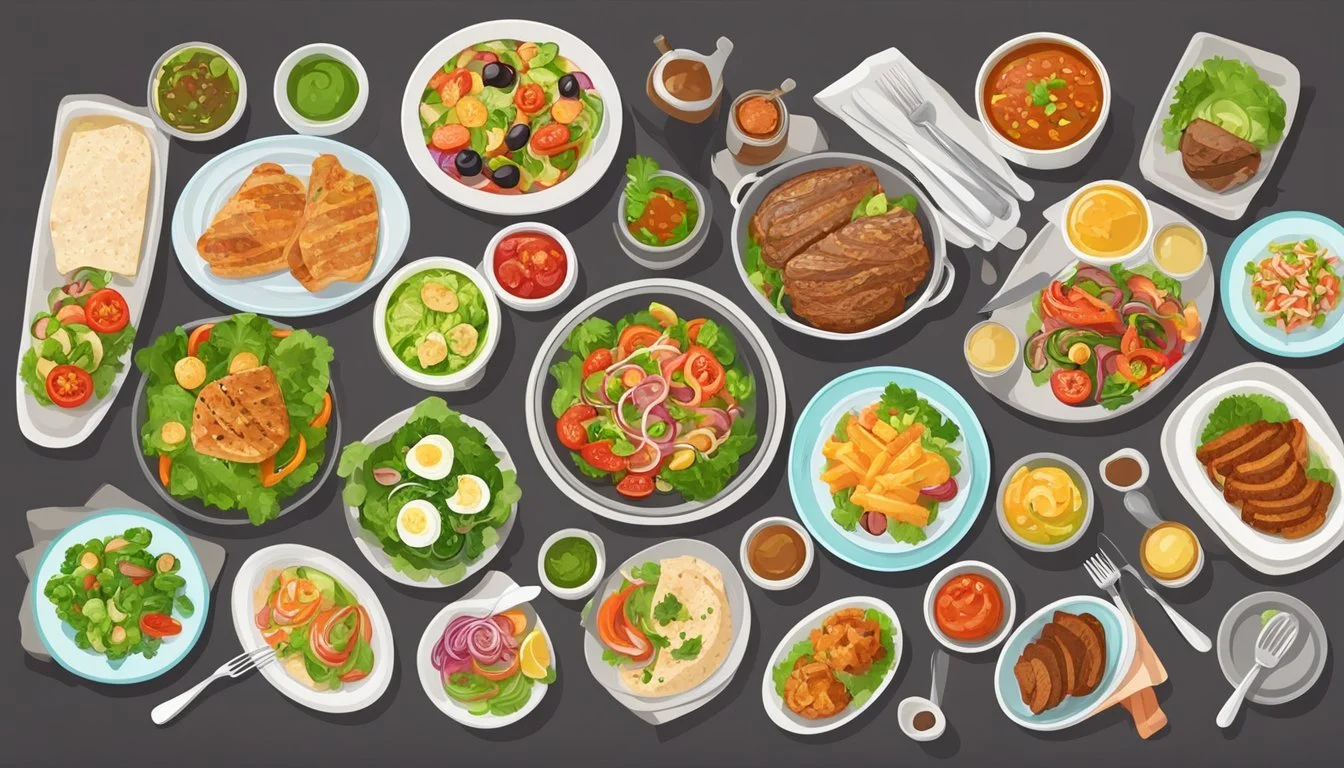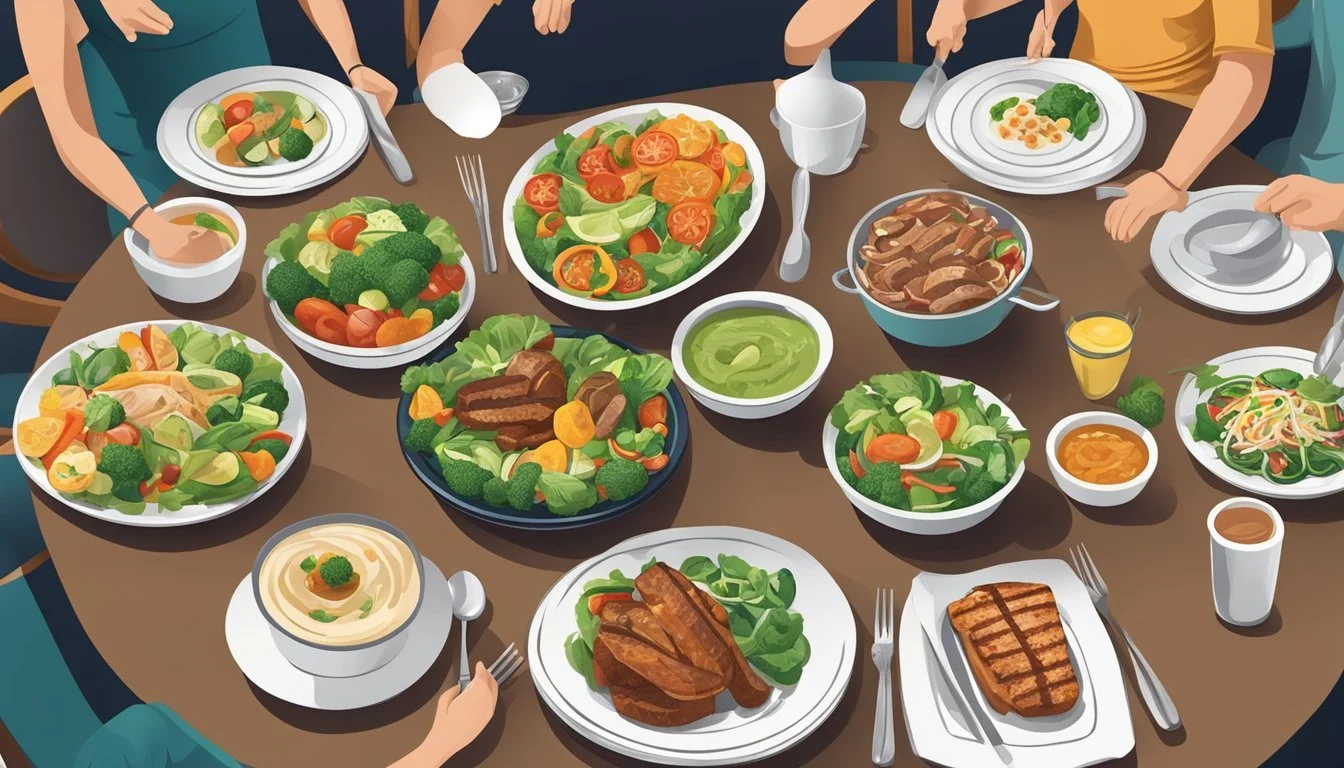Eating Out
A Guide to Grain-Free Options at Leading Chain Eateries
Eating out while adhering to dietary restrictions can often present a challenge. For individuals following a gluten-free, paleo, or grain-free diet, finding restaurants that cater to their needs is essential, not only for convenience but also to maintain their health and well-being. People might choose these diets due to health conditions such as celiac disease, gluten sensitivity, or simply for a personal preference towards a healthier lifestyle. Restaurants are increasingly recognizing the importance of providing options that suit these dietary requirements, making it easier for diners to enjoy a meal out without compromising on their health goals.
Many popular restaurants now offer a range of grain-free and gluten-free options, signaling a shift in the food industry towards more inclusive menu choices. Patrons following a paleo diet, which emphasizes whole foods and eliminates grains, dairy, and processed foods, can also find suitable options, though this often requires more careful selection and sometimes customizing menu items. Success in maintaining these diets while dining out is possible with a little research and knowledge about what to look for and the right questions to ask.
Navigating menus can be simplified with tools like dedicated gluten-free menus or certifications that indicate the restaurant accommodates such dietary needs. While not all eating establishments will have a specialized menu, many are willing to adapt their dishes to remove grains or other non-compliant ingredients upon request, as long as diners communicate their dietary restrictions clearly to the staff. It's beneficial both for those with food sensitivities and the restaurants that serve them to foster understanding and provide options that ensure a safe and enjoyable dining experience.
When dining out, maintaining a grain-free lifestyle can be both enjoyable and effortless with a little know-how and preparation. Many restaurants now offer diverse and flavorful options that cater to grain-free dietary preferences, allowing you to savor a variety of cuisines while staying true to your health goals.
Exploring grain-free international cuisine during dining outings provides an exciting opportunity to indulge in a world of flavors and cultural traditions. From savoring zesty Mexican dishes to relishing aromatic Thai cuisine, there are abundant grain-free choices to delight your taste buds.
Understanding the significance of grains in human health history can deepen your appreciation for embracing a grain-free lifestyle, and when dining out, being mindful of grain-free hidden grains labels ensures that you can make informed choices that align with your dietary needs.
For pet owners, some restaurants even offer grain-free dog treats to pamper your furry companions while you enjoy your meal. It's a heartwarming way to include your pets in the dining experience and prioritize their well-being.
Equipped with knowledge about grain-free flour alternatives and a well-stocked grain-free kitchen pantry at home, you can confidently navigate dining options and make informed choices that support your grain-free journey.
By embracing the abundance of grain-free dining options and being mindful of ingredients, you can savor delicious meals, celebrate diverse cuisines, and enjoy dining out while staying committed to your grain-free lifestyle.
Understanding Grain-Free Diets
When exploring grain-free diets, one must comprehend the basic tenets of this eating pattern, along with the potential benefits and difficulties it presents. It's a diet that focuses on the exclusion of grains but not necessarily other foods like dairy or sugar, encouraging whole, unprocessed foods.
Key Principles of a Grain-Free Diet
A grain-free diet eliminates all grains, including wheat, rice, corn, barley, and oats. Grains are often excluded due to their potential to cause inflammation or digestive issues. Paleo and gluten-free diets also restrict certain grains, but for different reasons. For example, the Paleo diet is based on whole foods and mimics what might be consumed during the Paleolithic era, which inherently excludes most grains. This diet encourages the consumption of fruits, vegetables, lean meats, fish, and seeds.
Foods to Avoid Foods to Include Wheat Leafy greens Corn Meat Rice Fish and Seafood Barley Eggs Oats Dairy (in some cases) Rye Legumes (in some cases)
Benefits and Challenges of Grain-Free Eating
Benefits:
Weight Loss: Some individuals experience weight loss on a grain-free diet due to reduced calorie intake from cutting out high-calorie grains.
Digestive Health: People with digestive issues like bloating or celiac disease may find symptom relief without grains.
Reduced Inflammation: Those with inflammatory conditions may notice an improvement in symptoms when avoiding grains which can be inflammatory for some.
Challenges:
Nutritional Deficiencies: Grains are sources of fiber and vitamins. Without them, one can risk deficiencies unless careful to compensate with other foods.
Difficulty Dining Out: Many restaurants include grains as part of their meals, which can make sticking to a grain-free diet challenging.
Restrictive Nature: A grain-free diet can feel limiting and may lead to a sensation of deprivation if not well-planned.
The term "grain-free" is not synonymous with "gluten-free" as the latter only excludes gluten-containing grains. Moreover, grain-free diets are not inherently low in sugar or processed foods; one must actively choose unprocessed options and monitor sugar intake. Individuals with diabetes may gravitate towards a grain-free diet to help manage blood sugar levels, but it requires careful planning to ensure nutritional balance. It's also essential to distinguish between grain-free and gluten-free products, as the latter may still contain grains, such as corn or rice, that do not have gluten.
A grain-free diet is not for everyone, but for those with specific dietary needs or health objectives, it may provide a beneficial framework.
Identifying Hidden Grains and Gluten
When dining out, it's crucial for individuals with grain or gluten sensitivities to be aware of the not-so-obvious sources of these ingredients. This knowledge is essential to maintain a grain-free and gluten-free diet while enjoying a meal outside the home.
Common Foods That Contain Grains
Grains are often found in a variety of commonplace foods that one might not initially suspect. Due to culinary practices, even some items that traditionally do not contain grains may be modified to include them. Here are some examples:
Sauces and Gravies: Can be thickened with flours made from wheat, rye, or barley.
Processed Meats: Items like sausages and deli meats sometimes use grain fillers.
Soups: May include grains for thickening or as part of the recipe, such as barley in beef barley soup.
Breaded Foods: Watch out for any fried or baked items with a crispy coating.
Salad Dressings: Certain dressings may have malt vinegar, made from barley, or wheat-based thickeners.
Alcohol: Some beers and malts contain barley; whiskey is often distilled from barley, rye, or wheat.
Understanding Food Labels and Ingredients
Diners must be diligent when reading food labels and asking about ingredients to successfully avoid grains and gluten. Here is how one can approach this:
Certification Labels: Look for the gluten-free certification on food labels.
Ingredient Lists: Be alert for terms like triticale, spelt, and kamut, which indicate varieties of wheat.
Allergen Source: If a product includes allergen information, it may specify the source of potential allergens like wheat.
Cross-Contact: Be wary of statements that mention the potential for cross-contact with wheat in the facility.
Restaurants often have allergen menus or nutrition facts that can aid in identifying grain-free options. It's beneficial to call ahead or ask the server about the specifics of meal preparation and potential hidden grains.
Navigating Popular Restaurant Menus
Choosing grain-free options at restaurants requires attention to detail and an understanding of each restaurant's menu offerings.
Tips for Dining Out on a Grain-Free Diet
When dining out on a grain-free diet, patrons should focus on meals that predominantly feature proteins and vegetables. They should review the menu beforehand, if possible, and keep an eye out for key ingredients such as meats, fish, seafood, and a variety of vegetables. Requesting sauces or dressings on the side allows diners to control the addition of potentially grain-containing condiments. It's also beneficial to ask for any available substitution options, like replacing a grain side with a salad or steamed vegetables.
Review menus ahead of time: Look for grain-free options like salads, proteins, and vegetable sides.
Ask questions: Inquire about modifications to make dishes grain-free.
Substitute wisely: Swap out grain sides for extra vegetables or a salad.
Restaurants with Grain-Free Options
Chipotle offers customizable salad bowls which can be made grain-free by forgoing rice and beans. Order the Paleo Lifestyle Bowl, with romaine, chicken, fajita veggies, tomatillo salsa, and guacamole.
Restaurant Grain-Free Option Notes Burger King Bunless burger options Customizable, can remove the bun Shake Shack Lettuce-wrapped burgers Alternative to the traditional bun Starbucks Protein boxes without the grains Usually include cheese, vegetables, and hard-boiled eggs
Fast food can be a bit more challenging, but most places will accommodate by serving burgers without the bun (e.g., Burger King) or providing lettuce wraps (e.g., Shake Shack). Some restaurants, like Chipotle, have distinct grain-free dishes like salad bowls that comply with a grain-free diet. Patrons should still verify ingredients to ensure compliance with their dietary needs. Additionally, Starbucks offers protein boxes, which, if grains are excluded, can provide a satisfying grain-free snack.
Chipotle: Paleo Lifestyle Bowl is an excellent grain-free choice.
Burger King: Opt for a bunless burger place.
Shake Shack: Choose lettuce wraps instead of buns for their burgers.
Starbucks: Select protein boxes, removing any grains included.
Grain-Free Choices at Fast Food Chains
For those seeking to avoid grains, many fast food chains offer options that can be customized to fit a grain-free diet or already have specific items that are grain-free by design.
Customizing Orders for Grain-Free Needs
In various fast food establishments, guests can modify standard menu items to align with grain-free requirements. Burger King allows patrons to replace the usual bun with a lettuce wrap, reducing the grain content of their classic burgers. Chipotle offers customizable bowls, providing a base of greens instead of rice, making it possible to construct a grain-free burrito bowl. Similarly, Shake Shack caters to grain-free consumers by providing lettuce wraps as an alternative to traditional buns.
Common Grain-Free Modifications:
Burger King: Opt for a lettuce wrap instead of a bun.
Chipotle: Choose a salad base instead of rice or tortillas.
Shake Shack: Request a lettuce wrap for burgers.
Grain-Free Menu Items Worth Mentioning
Several fast food chains have menu items that inherently do not contain grains. For example, Shake Shack has menus that offer gluten-free options like milkshakes and floats. When considering sides, Burger King provides hash browns that, while not strictly grain-free, can be an option for those avoiding wheat or traditional grains. A more fitting choice might be garden salad or grilled chicken. It's crucial to verify individual restaurant policies and preparation methods to ensure no grain cross-contact for those with high sensitivity.
Notable Grain-Free Items:
Salads: Available at most chains, like the grilled chicken salad option.
Sides: Certain sides like apple slices or hash browns in some places.
Burgers: Without the bun or with a lettuce wrap, such as at Burger King.
Sit-Down Restaurants and Grain-Free Eating
Navigating grain-free options at sit-down restaurants can be seamless with the right approach. Patrons who follow a grain-free diet, such as paleo or gluten-free lifestyles, can still enjoy a fulfilling dining experience with a variety of meal selections.
Selecting Grain-Free Meals at Sit-Down Restaurants
When choosing meals, diners should focus on protein sources and fresh produce. Meat is often a safe choice, with options like steak and grilled chicken being widely available and generally free of grain-based ingredients. Fish and seafood are excellent protein options that also provide essential omega-3 fatty acids. For sides, one can opt for steamed or roasted vegetables tossed in olive oil, or a fresh salad, ensuring dressings are confirmed grain-free.
Here's a brief guide on what to look for:
Protein Options:
Grilled or baked meat: chicken, steak, pork
Seafood: shrimp, salmon, grilled fish
Dairy: cheese (in moderation), butter
Vegetables: a variety pile of steamed, sautéed, or raw vegetables
Salads: ask for olive oil and vinegar or lemon juice as dressing
Avoid breaded items or dishes where pasta or pizza is a central element. It's beneficial to inquire about sauces and dressings, as they may contain hidden grains or sugars.
Desserts and Beverages to Consider
Dessert options without grains can be limited at sit-down restaurants. Patrons may opt for a platter of fruit, which offers natural sweetness without added sugars or grains. Some establishments may offer grain-free dessert specialties such as mousse, which typically contain dairy but no grains.
For beverages, plain coffee or tea without added sweeteners are safe grain-free choices, and some find indulgence in a glass of wine. It's important to avoid beer, malt beverages, and cocktails with syrups that could contain grain-derived ingredients.
Here's a simplified list of suitable after-meal options:
Desserts:
Fruit platter
Cheese selection
Grain-free mousse
Beverages:
Black coffee
Herbal or green tea
Wine (red or white)
By being vigilant with menu choices and asking informed questions about the ingredients, patrons can enjoy a satisfying grain-free dining experience at their favorite sit-down restaurants.
Making Healthy Choices Beyond Grains
When dining out on a grain-free diet, it is essential to focus on the balance of macronutrients and micronutrients, as well as to avoid other potential allergens and inflammatory foods. The aim is to ensure a range of nutrients while adhering to dietary restrictions.
Balancing Macronutrients and Micronutrients
For individuals following a grain-free diet, the balance of macronutrients - proteins, fats, and carbohydrates - is crucial. Protein sources like fish, eggs, and legumes can be excellent choices, offering both essential amino acids and micronutrients. Fish, for instance, provides omega-3 fatty acids which are important for heart health.
Fiber is another important consideration. While grains are a common source, there are plenty of alternatives:
Vegetables such as leafy greens
Fruits like berries and apples
Nuts and seeds, including flaxseeds and almonds
These not only contribute to fiber intake but also offer a variety of vitamins and minerals, such as iron and magnesium. Ensuring a variety of these foods can also supply essential trace minerals.
Avoiding Other Common Allergens and Inflammatory Foods
Beyond grains, individuals may seek to avoid other allergens, such as dairy or soy. Utilizing substitutes like coconut aminos in place of soy sauce can help adhere to a soy-free regimen. Legumes, like beans and peanuts, may be eliminated in paleo or specific grain-free diets, while seeds can serve as nutrient-dense alternatives.
For those avoiding sugar, focusing on whole foods rather than processed options can limit sugar intake. Choosing starchy vegetables with caution is wise, opting for those like sweet potatoes that offer more nutrients and a lower glycemic index. Salads with a base of leafy greens are typically a safe bet, though one should be wary of sugary dressings or croutons, which may not align with a grain-free or gluten-free lifestyle.
Conclusion
Eating out while adhering to a grain-free diet such as Whole30 or keto is entirely feasible. Restaurants are increasingly accommodating the needs of customers with special dietary requirements. Individuals with health conditions that demand grain-free options can navigate menus with confidence, often finding establishments that offer gluten-free and grain-free choices. Additionally, the shift toward a more sustainable approach to eating means more restaurants are focusing on whole foods, which aligns well with grain-free diets.
For those new to grain-free dining out, here are some key strategies:
Prioritize restaurants that explicitly cater to grain-free options.
Consult the menu in advance to identify suitable dishes.
Don't hesitate to speak with the staff, as they are generally knowledgeable and can assist with menu choices.
Consider the ingredients, focusing on proteins like meat, fish, and eggs, as well as an array of vegetables.
Engage in community forums or restaurant review platforms to share experiences and learn from others.
A proactive approach to dining out can turn it into an enjoyable and stress-free experience. With the increasing visibility of grain-free diets, restaurants are adapting to meet the demand, making it easier for consumers to maintain their health goals without sacrificing the pleasure of dining out.







